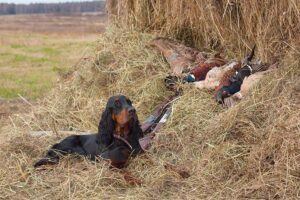
Gordon Setter Club of America | Beauty, Brains and Bird Sense
For as long as anyone can remember, the motto of the Gordon Setter Club of America Inc. has been “Beauty, Brains and Bird Sense.”
Home » Meet The Breeds » Gordon Setter


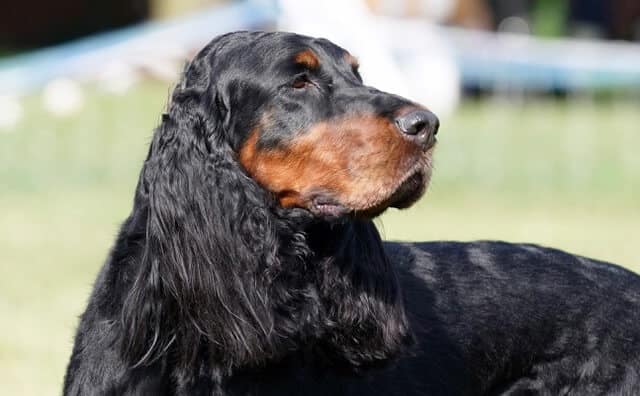
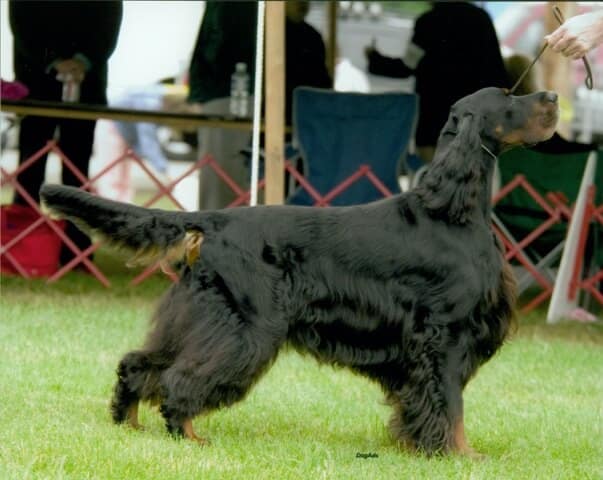
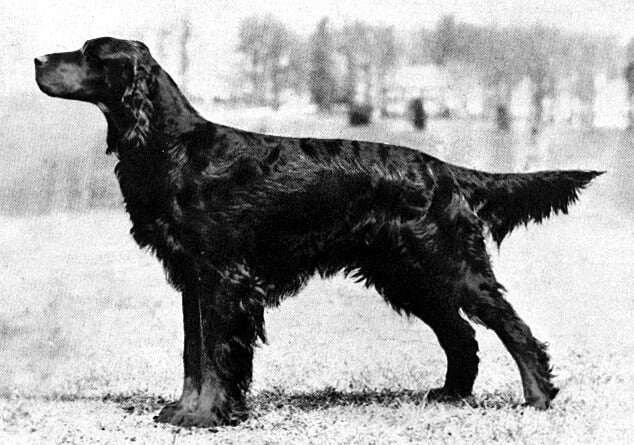
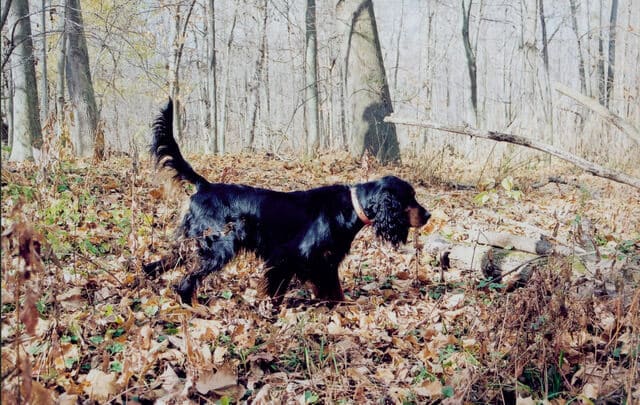
Gordon Setter Club Of America, Inc.
14/03/2025
Gordon Setters were initially bred as bird dogs, for hunting birds like pheasant and quail. Although the hunting instinct remains strong in the breed, Gordons are equally at home as companion dogs, obedience and agility competitors, and show dogs. Gordon Setters are alert and lively, pleasant, and exceedingly loyal. They tend to be devoted to members of their household but are not overly friendly to strangers. As a general rule, Gordons tend to tolerate attention from people they do not know rather than seeking such attention. Gordons are highly intelligent dogs, as quick to spot an advantage as to spot game.
Sporting
23 – 27 inches
45 – 80 pounds
12 – 14 years
| Country of Origin | Scotland |
|---|---|
| Bred For | Personal Hunting Dog |
| Known For | The motto of the Gordon Setter Cub of America for the Gordon Setter is “Beauty, Brains and Birdsense.” This is a beautiful dog who can do a day’s work in the field. Distinctive black and tan coloring. The Gordon Setter was one of the first nine breeds recognized by the American Kennel Club in 1878. |
| Popularity | Moderate – Ranked No. 99 out of 201 breeds based on 2023 AKC statistics. |
| Temperament | Alert, Gay, Interested, Confident |
| Activities | Hunting, Hunting Tests, Field Trials, Conformation Shows, Obedience/Rally, Agility, Scent Work and just about any other AKC Sports. |
Literature tells us that the Setter was in existence as early as the 1500s or early 1600s. The name “Setter” was coined because the dog would locate a bird and “sit” or lay down, showing the hunter where the bird is and the hunter would throw a net over the dog and bird.
The major differences between the Setter breeds is the terrain in which it hunts. The Gordon, being heavy-boned and square, suggests strength and stamina rather than speed over the craggy terrain of Scotland.
Alexander Gordon, 4th Duke of Gordon, established his kennel of Black and Tan Setters at Gordon Castle, which was situated near Fochabers, not far from the River Spey and a few miles from the coast of Moray. The exact date when this occurred is not known.
These first Setters looked more like the field English Setters. The Duke crossed the Setters with the flat-coated black and tan Collie. These dogs were good for hunting and herding. Other breeders used Bloodhounds, black Pointers, and solid black Setters.
The First documented import of Gordon Setters to the US was in 1842 when George Blunt of New York brought Rake and Rachael. Rachael was given to Daniel Webster.
The Gordon Setter is a good-sized, sturdily built, black and tan dog, well-muscled, with plenty of bone and substance. The Gordon is active, upstanding and stylish, appearing capable of doing a full day’s work in the field. He has a strong, rather short back, with well-sprung ribs and a short tail. The head is fairly heavy and finely chiseled. His bearing is intelligent, noble, and dignified, showing no signs of shyness or viciousness. Clear colors and a straight or slightly waved coat are correct. He suggests strength and stamina rather than extreme speed. Symmetry and quality are most essential. A dog well balanced in all points is preferable to one with outstanding good qualities and defects. A smooth, free movement, with high head carriage, is typical. On a scale of 100 points, Size and General Appearance are worth 15 points.
Males stand 24 to 27 inches tall at the shoulder, while females; females measure 23 to 26 inches in height. Weight for males is 55 to 80 pounds, and 45 to 70 pounds for females.
The distance from the forechest to the back of the thigh is approximately equal the height from the ground to the withers. The Gordon Setter has plenty of bone and substance. Animals that appear to be over or under the prescribed weight limits are to be judged on the basis of conformation and condition. Extremely thin or fat dogs are discouraged on the basis that under or overweight hampers the true working ability of the Gordon Setter. The weight-to-height ratio makes him heavier than other Setters.
Texture: Soft and shining, straight or slightly waved, but not curly, with long hair on ears, under stomach and on chest, on back of the fore and hind legs, and on the tail. The feather which starts near the root of the tail is slightly waved or straight, having a triangular appearance, growing shorter uniformly toward the end. Heavily coated dogs require grooming beyond brushing and bathing. Hair beneath and between the toes should be trimmed. On a scale of 100 points, coat is worth eight points.
Colors
• Black with Tan Markings, either of rich chestnut or mahogany color. Black penciling is allowed on the toes. The borderline between black and tan colors is clearly defined. There are no tan hairs mixed in the black.
Markings
• Rich Chestnut
• Rich Mahogany
A Note About Color: The Gordon Setter is black with Tan Markings, either of rich chestnut or mahogany color. Black penciling is allowed on the toes. The borderline between black and tan colors is clearly defined. There are no tan hairs mixed in the black. The tan markings are located as follows: (1) Two clear spots over the eyes and not over three-quarters of an inch in diameter; (2) On the sides of the muzzle. The tan does not reach to the top of the muzzle from one side to the other; (3) On the throat; (4) Two large clear spots on the chest; (5) on the inside of the hind legs showing down the front of the stifle and broadening out to the outside of the hind legs from hock to the toes. It must not completely eliminate the black on the back of the hind legs; (6) On the forelegs from the carpus, or a little above, downward to the toes; (7) Around the vent; (8) A white spot on the chest is allowed, but the smaller the better. Disqualification: Predominantly tan, red or buff dogs are ineligible for showing and undesirable for breeding. On a scale of 100 points, color and markings are worth five points.

The tail is short and not reaching below the hocks, carried horizontal or nearly so, not docked, thick at the root and finishing in a fine point. The placement of the tail is important for correct carriage. When the angle of the tail bends too sharply at the first coccygeal bone, the tail will be carried too gaily or will droop. The tail placement is judged in relationship to the structure of the croup.
Gordon Setters are wonderful family dogs and personal companions. Many Gordons are great talkers. They can develop quite a vocabulary with various tones to express themselves. Constant wagging of the tail seems to be part of their style as well. Gordon Setters thrive when they share both hearth and field with their owners. They do not enjoy being part of a kennel string. Gordon Setters do shed, so if you are looking for a breed that does not, this is not a breed for you.
Gordon Setters are basically healthy dogs. Still, as with many other breeds, Gordons are subject to a few health concerns. Screening is available for many of these conditions. The Gordon Setter Club of America participates in the OFA CHIC program and believes in health testing and research.
Lifespan: Gordon Setters can live into their late teens, but most live 12-14 years.
The Gordon Setter Club recommends that all Gordons be screened for the following:
Alert, gay, interested, and confident, the Gordon Setter is fearless and willing, intelligent, and capable. He is loyal and affectionate, and strong-minded enough to stand the rigors of training. He is noble and dignified, showing no signs of shyness or viciousness. On a scale of 100 points, temperament is worth 10 points.
Gordon Setters should be fed a high-quality diet with balanced nutritional levels. Gordons do best with twice a day feedings. Dogs should not be allowed to be over or underweight.
There is no denying a Gordon would prefer to stay a “puppy” forever, but with proper techniques, a young Gordon can be trained without breaking his spirit. Gordons are highly intelligent dogs, as quick to spot an advantage as to spot game, and basic obedience training will make your Gordon a better companion and a better canine citizen. Although Gordons are bright, they are not blindly obedient and may seem stubborn. Firmness and consistency are the keys to handling Gordons; harsh treatment is NEVER necessary. Obedience classes, ranging from puppy kindergarten to advanced competition, are available in most areas through local kennel clubs and/or professional training organizations.
Gordons are capable of adapting to a variety of living situations, as long as they are assured of the love of their owners. They do, however, need plenty of daily exercise to maintain peak physical and mental condition. Gordons need a safe, fenced area in which to run and play, and/or should be taken for frequent on-leash walks or exercised in a safe space, under control, never unsupervised.
| Energy Level | Moderate |
|---|---|
| Exercise Requirements | The Gordon Setter needs regular exercise and does well with mental stimulation. They can be fine apartment-dwelling dogs with appropriate exercise. |
Daily brushing is recommended as is monthly (or more frequent) bathing. Heavily coated dogs require grooming beyond brushing and bathing. Frequent nail trims, routine ear cleaning, and routine tooth brushing/cleaning are also necessary. The hair beneath and between the toes should be trimmed. Many owners who do not show their dogs seek out the assistance of a professional groomer to keep their dogs looking nice and keep shedding to a minimum.
| Coat Type | Soft and Shining, Straight or Slightly Waved but not Curly |
|---|---|
| Grooming Requirements | Daily Brushing, Monthly (or More Frequent) Bathing, Frequent Nail Trims, Routine Ear Cleaning, Routine Tooth Brushing/Cleaning |
Gordon Setters are great family dogs. They are devoted to the members of their household, and often have a “favorite.” Gordons are not blindly obedient and can come across as stubborn. Training must be an integral part of Gordon Setter ownership. Gordons are happy, they can be vocal, and they are usually very sweet.
There is nothing cuter than a Gordon Setter puppy. They can wrap you around their paw in no time flat.
To build the foundation for a well-trained adult, the Gordon Setter puppy must be trained with gentle consistency from the time it is very young. The Gordon puppy should be vaccinated according to your veterinarian’s protocol. After vaccination, the puppy should be exposed to other dogs, children, and everyday things they may encounter.
Gordon Setters are seen in a variety of organized events, including:
With proper training, a Gordon can pretty much do it all!
The Gordon Setter is recognized by the world’s leading registries and kennel organizations, which categorize the breed into a specific Group based on its unique characteristics. This breed is recognized worldwide under the following Group designations:
| Organization | Group Designation |
|---|---|
| AKC (American Kennel Club) | Sporting |
| UKC (United Kennel Club) | Gun Dog |
| CKC (Canadian Kennel Club) | Sporting Dogs |
| ANKC (Australian National Kennel Council) | Gundogs |
| RKC (The Royal Kennel Club) | Gundog |
| FCI (Fédération Cynologique Internationale) | Group 7 – Pointing Dogs; Section 2 – British and Irish Setters; 2.2. Setters |
The ideal Gordon Setter is described by a Breed Standard that is approved by each of the world’s leading registries and kennel organizations. The Breed Standards for this breed may be found in the following links:
| Organization | Breed Standard |
|---|---|
| American Kennel Club | AKC Gordon Setter Breed Standard |
| United Kennel Club | UKC Gordon Setter Breed Standard |
| Canadian Kennel Club | CKC Gordon Setter Breed Standard |
| Australian National Kennel Council | ANKC Gordon Setter Breed Standard |
| The Royal Kennel Club | RKC Gordon Setter Breed Standard |
| Fédération Cynologique Internationale | FCI Gordon Setter Breed Standard |
The Gordon Setter Club of America has over 800 members and governs the Standard for the breed. There are many events held under the auspices of the club. The club has non-profit foundations for both Rescue and Health. There are also five Independent Gordon Setter Specialty Clubs. A newsletter is published eight times a year.
The Gordon Setter Club of America has a National Rescue Coordinator who works with Gordon Setter Rescue Regional Coordinators to find and foster homeless Gordons. Dogs are evaluated in foster homes and are placed in vetted homes. The club always attempts to find the breeder of a dog. The process for placing dogs means that the club re-homes very few dogs after rescue placement.
(Courtesy of the Gordon Setter Club of America Illustrated Standard)
Gordon Setters are bred to run and find birds. Even if your dog will never be used as a hunting companion, it will still need a lot of exercise. Sitting in the backyard does not count as exercise.
With the long coats that are common with Gordons, weekly brushing and combing is a must to avoid matting and knotting of their coats. It is also very important to keep their nails, and the hair on the bottom of their feet and between the toes, trimmed, otherwise it may cause their feet to breakdown.
Gordon Setters are a little difficult to find. AKC Marketplace may have listings for Gordon Setter puppies. The Gordon Setter Club of America Breeder Referral Coordinator keeps a list of members expecting puppies. Periodically, rescue dogs become available around the country. There may be a great opportunity to adopt one of these dogs.
Gordon Setters—even puppies—love to drink water. Your vet can examine your dog for diabetes, but that is not common in Gordon Setters.
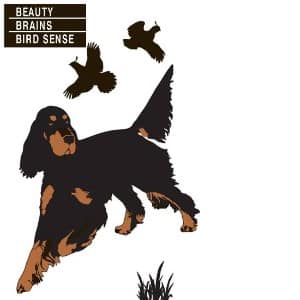
The Gordon Setter Club of America, Inc. is a not for profit organization dedicated to promoting and preserving the “Beauty, Brains & Bird Sense” in Gordon Setters. The club was organized in 1924 and currently has about 800 members. Most of our membership is concentrated in the United States, but we also have members from 15 to 20 countries worldwide. The GSCA’s certificate of incorporation was issued by the state of New York on January 14, 1965.

For as long as anyone can remember, the motto of the Gordon Setter Club of America Inc. has been “Beauty, Brains and Bird Sense.”

Rhonda Cornum of Munroc Gordon Setters shares her journey breeding Dual Champions with purpose, passion, and field-worthy integrity.
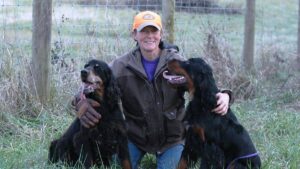
Rhonda Cornum is the breeder behind Munroc Farm Kennel Gordon Setters. Read about the kennel’s beginnings, puppies, and much more!
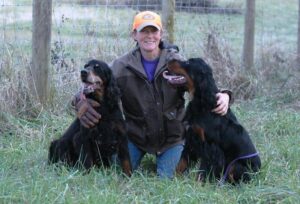
Rhonda Cornum is the breeder behind Munroc Farm Kennel. Read about the kennel’s beginnings, breeding philosophy, puppies, and more!

Rhonda Cornum is the breeder behind Munroc Farm Gordon Setters. Read about the kennel’s beginnings, champions dogs, puppies, photos & more!
The best way to ensure a long and happy relationship with a purebred dog is to purchase one from a responsible breeder. Not sure where to begin?
Contact the National Parent Club’s Breeder Referral Program, which is listed on the AKC Breeder Referral Contacts page.
